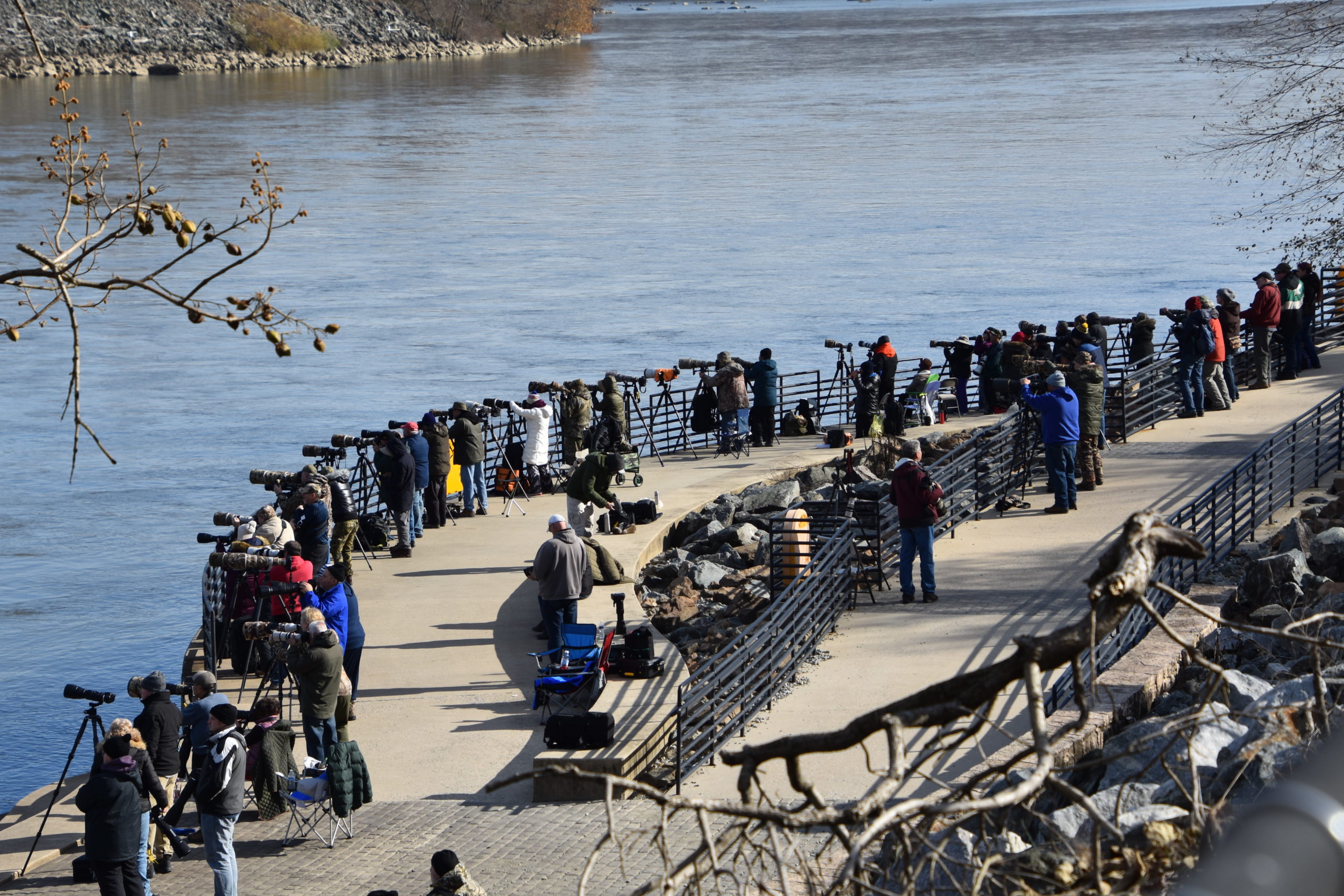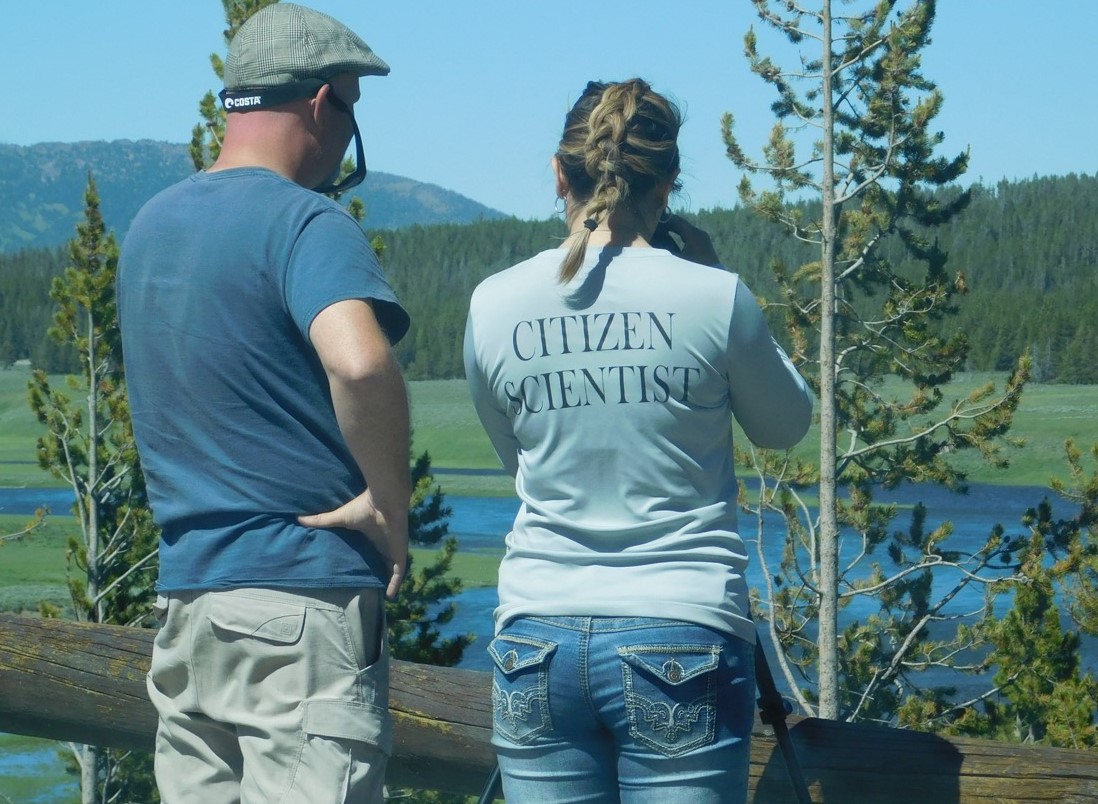Article begins
How does the dominant narrative portray nature tourists? And how might we all benefit from a more inclusive view?
The human face of outdoor recreation, nature tourism, and wilderness in the United States has typically been a white one. Visitors to parks and participants on ecotours tend to share the same “white middle-class view” making nature tourism an experience that fits comfortably with their existing worldviews on wild spaces and conservation. This lack of inclusivity has prompted many who don’t share this view to ask, “What happens if I am not white? How do I fit into the existing outdoor narrative?” To help answer these questions we need to think about who today travels in nature and how that “who” can become more inclusive.

Image Description: A group of approximately 40 warmly-dressed adults are standing or sitting and waiting with spotting scopes on the concrete deck adjacent to the Conowingo Dam on the Susquehanna River to spot some eagle activity.
Caption: Eagle watchers at Conowingo Dam in Maryland. Barbara Jones
According to natural resource managers and individuals who work in nature or ecotourism, “The visitor who comes tends to be college educated, with at least $100,000 a year household income. They fit most outdoor enthusiast profiles…, they also tend to be a certain age and that fits [Lee County, Florida’s] visitor profile nicely”; visitors to Edwin B. Forsythe National Wildlife Refuge (New Jersey) tend to be “older, white people”; Florida bike tourists are pretty much “white haired, white people…”; and urban foragers and birdwatchers in New York City tend to be “white, wealthy, and 25–40 years of age.” However, in New York City’s Central Park, this entrenched notion of who belongs in nature was recently challenged. A white woman walking her dog off leash assumed a Black male birdwatcher who asked her to leash her dog was a safety threat so she called the police. Although this man was a long-time birdwatcher and a common sight in the park, by relying on a persistent white-in-nature narrative that conflicted with the idea of a Black birdwatcher, the woman not only lost her job but earned the moniker “Central Park Karen.” Such an outcome suggests that the old message about who engages in nature is undergoing a major rewrite.
For the National Park Service, in 2016, 82 percent of the visitors to Yellowstone National Park were white and only a quarter of the visitors were under 19 years old. In Yosemite National Park, William Tweed, a long-time national park employee, writing in his book Uncertain Path, recognized the missing tourist as a real problem for the future of national parks. To him, “wilderness remains tied to one segment of society.” He described an example of hiking in the backcountry of Yosemite and seeing a trail community that was “almost completely Anglo,” but upon returning to the trailhead he saw “Hispanics, Asians, and [B]lacks – modern California, in short.” Experiences like these remind us that connecting with and including all Americans is critical for the future of our wild and natural spaces.
The history of travel into nature has been critical in creating and maintaining the current outdoor travel narrative. Today’s nature travelers are not that different from the outdoor explorers of the nineteenth and early twentieth centuries. They see strenuous leisure like mountain climbing as “pioneering in a modern way” or define themselves through a “hipster backwoods aesthetic” that is attracted to locally produced handcrafts, drinks hand-roasted coffee, and moves through nature in the guise of an unconventional, experiential traveler. Related to this way of understanding or engaging with nature travel is the “hipster harvester” or “wild foody” who lives in urban settings such as Philadelphia or New York City. European colonialism, wealth, leisure time, and distance from nature have led to a nature narrative controlled and perpetuated by a very specific worldview.

Image description: A white adult man and woman stand side-by-side at a wilderness overlook in Yellowstone National Park. Their backs are visible; the man has on a plain blue t-shirt, while the woman is wearing a grey t-shirt with the words “citizen scientist” visible on the back. Beyond them is a view of Hayden Valley, with its blue lake and green meadow. The valley is surrounded by forest. There are a few trees near them. They are standing in a small parking area, leaning against a log railing.
Caption: Citizen scientists provide additional eyes on nature and help wildlife biologists collect critical data. In Hayden and Lamar Valleys in Yellowstone National Park, because of the chance to see wolves, wolf watchers as citizen scientists are a common sight. Barbara Jones
Media representations that reinforce this view typically depict white people in nature. Adventures for Hopi, The Nature Conservancy, African American Explorations, and Arctic Youth Ambassadors are examples of organizations advocating for a more inclusive narrative. They are striving to empower all people to see nature outside what Jessica Kutz writing in the January 16, 2020 issue of High Country News described as the domain of the special pants and a granola bar. Glenn Nelson writing in a June 27, 2016 issue of that same publication described a type of advocate who offers an alternative to that special-pants-white-narrative, one that includes a Hopi named Marshall Masayesva who sees Native Alaskans as some of the first kayakers and Ancestral Puebloans as amazing climbers. He believes, “It’s not that we can’t [kayak or mountain climb].” Or Teresa Baker who in her African American Explorations blog highlights how the absence of “black and brown faces atop billboards for athletic clothing and equipment” fails to convey the “message that every face matters, every voice matters.” To her, if we want “people of color” to care about our open spaces those faces must be included.
Individuals seeking out “life affirming” experiences that come through traveling as citizen scientists or as eco-volunteers typically value nature already and do not see conservation and preservation in conflict with those values. However, the failure to demonstrate a positive connection between protecting the environment and human well-being can lead many people to see environmental preservation as a luxury good where environmental stewardship outprices itself. In addition, if the costs associated with ecotourism and nature travel are prohibitively high, those costs become a barrier to participation. For nature immersion to have a broader appeal, it becomes essential to highlight both the economic and the ecological benefits healthy ecosystems can provide; otherwise, the environmental interpreter or in-nature experience preaches to an already existing “choir.”
A more inclusive narrative must generate educational opportunities that encourage immersion into nature for everyone. As missing advocates for nature push against existing boundaries, forming internships that recruit from nontraditional sources can have a significant impact. Arctic Youth Ambassadors offers internships that take young people from all walks of life into nature. Opportunities like that can move a young person from seeing nature as dangerous or scary to one that sees nature as critical to their lived experience. A group called Blackfeet Outfitters offers “Native Cultural Experiences” that take visitors to Montana into the ecological and cultural world of the Blackfeet, while bilingual birding tours are working to forge deeper connections between culture and nature by making space for local ownership of bird names. Efforts like these make nature more welcoming, so those individuals who are typically left out can develop relationships with the outdoors in ways that are both highly personal and unique.
Redefining the existing white narrative by broadening the net through youth nature programs, bird or nature twitter feeds (like #BlackBirdersWeek or #unlikelyhikers ), education efforts, campaigns that show nature as “cool,” nature apps, time spent outdoors, and a reliance on more inclusive outdoor recreation advertisements and media representations is essential. By encouraging travel into nature, conservation groups can help empower all segments of society to see nature and wild spaces as critical to their lives. The result of this effort will be an increase in advocacy for everyone’s nature.
Barbara Jones is a professor of anthropology at Brookdale Community College. She is also the author of Wild Capital: Nature’s Economic and Ecological Wealth (2019).
Cite as: Jones, Barbara. 2020. ““New Advocates” for Our Wild Spaces.” Anthropology News website, October 2, 2020. DOI: 10.14506/AN.1511

